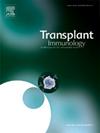Testing controls demonstrates a high prevalence of non-HLA antibody positivity using pre-defined cutoff threshold in a bead-based assay using healthy control population
IF 1.4
4区 医学
Q4 IMMUNOLOGY
引用次数: 0
Abstract
Background
Measuring non-HLA antibodies is a potentially important tool in assessing allograft dysfunction and needs to be correlated with clinical outcomes. Thus, determining the antibody distribution in healthy populations is important before correlating with clinical events. Using male blood donors, we selected a low immunological risk control cohort.
Methods
We analyzed samples from 92 male, non-transfused blood donors (donors) to assess the detection of antibodies in a normal population cohort using a non-HLA 33 antigen multiplex commercial assay.
Results
At manufacturer's suggested cutoff threshold (COT) of 75 % percentile, no donors had negative results and at 95 % percentile only three donors were negative across all 33 antigens. At each of the manufacturer's COT, the median (IQR) number positive antibody bead tests per donor was 13 (10–17), 11 (8–13) and 7 (5–10) at 75th, 85th and 95th percentile COT, respectively. There was poor correlation between manufacturer's COT and locally generated COT (range r = 0.520 to 0.595). The percentage of donors who had three or more positive antibody bead tests was: 98.9 % at 75th COT; 95.7 % at 85th COT and 93.5 % at 95th COT.
Conclusions
Considering the high proportion of positive results in a low immunological risk cohort, application of non-HLA antibody measurement in a diseased cohort is not optimal, and difficult to correlate with clinical events. Further studies to determine normal detection rates are needed for assay COT and clinical application in diseases.
在健康对照人群中,使用预先定义的头部检测切断阈值,测试对照显示非hla抗体阳性的高流行率
测量非hla抗体是评估同种异体移植物功能障碍的潜在重要工具,需要与临床结果相关联。因此,在与临床事件相关之前,确定健康人群中的抗体分布是很重要的。使用男性献血者,我们选择了低免疫风险控制队列。方法我们分析了92名男性非输血献血者(献血者)的样本,以评估使用非hla 33抗原多重商业测定法在正常人群队列中的抗体检测。结果制造商建议的截止阈值(COT)为75%,没有献血者结果为阴性,95%时只有3名献血者所有33种抗原均为阴性。在每个制造商的COT中,每个献血者在第75、85和95百分位COT中位数(IQR)阳性抗体头试验分别为13(10-17)、11(8-13)和7(5-10)。制造商的COT与当地产生的COT之间相关性较差(r = 0.520 ~ 0.595)。在第75次COT时,有3次或3次以上抗体头试验阳性的献血者百分比为:98.9%;95.7%在第85次COT和93.5%在第95次COT。结论考虑到低免疫风险队列中阳性结果比例较高,在患病队列中应用非hla抗体检测并非最佳选择,且难以与临床事件相关联。需要进一步的研究来确定正常的检出率,以用于检测COT和疾病的临床应用。
本文章由计算机程序翻译,如有差异,请以英文原文为准。
求助全文
约1分钟内获得全文
求助全文
来源期刊

Transplant immunology
医学-免疫学
CiteScore
2.10
自引率
13.30%
发文量
198
审稿时长
48 days
期刊介绍:
Transplant Immunology will publish up-to-date information on all aspects of the broad field it encompasses. The journal will be directed at (basic) scientists, tissue typers, transplant physicians and surgeons, and research and data on all immunological aspects of organ-, tissue- and (haematopoietic) stem cell transplantation are of potential interest to the readers of Transplant Immunology. Original papers, Review articles and Hypotheses will be considered for publication and submitted manuscripts will be rapidly peer-reviewed and published. They will be judged on the basis of scientific merit, originality, timeliness and quality.
 求助内容:
求助内容: 应助结果提醒方式:
应助结果提醒方式:


